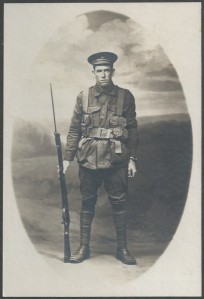Jack Henry HUNT

Jack Hunt, Lemaire Studios, Military Camp, Liverpool. Photograph courtesy of Iain and Judy Macdonald.
Per his military service record (regimental no. 4806), Jack Henry Hunt was born at Coonabarabran, N.S.W. [1] He gave his age as 18 years and 2 months, his marital status as single, and his occupation as station hand. His description on his medical was height 5 feet 10 ½ inches tall, weight 10 stone 7 lbs., with a dark complexion, hazel eyes, and dark hair. His religious denomination was Roman Catholic. He claimed that he had no previous military service. Along with his brother William Laurence Hunt, he completed his medical on the 9th October 1915 at Gilgandra, and was attested at Gilgandra on the same day by Captain Nicholas – the day before the commencement of the Coo-ee March. His service record included a consent form signed by his father C. H. Hunt.
After completing the march he went to Liverpool Camp, together with his father Charles Henry Hunt (who had caught up with the Coo-ees between Bathurst and Yetholme) and brother William Laurence Hunt, as reinforcement for the 13th Battalion.
At Liverpool on the 3rd February 1916, Private Hunt was charged with being absent from Parade on 2nd February 1916.
On his embarkation roll his address at time of enrolment was Wingadee, Coonamble, N.S.W., and his next of kin is listed as sister, Miss P. O. Hunt, St. Patrick’s Convent, Dubbo, N.S.W.
On 8th March 1916 Private Hunt, along with his father and brother, and many of the other Coo-ees, departed Sydney on the HMAT A15 Star of England, and arrived in Egypt on the 11th April 1916.
He was admitted to No. 2 Australian Stationary Hospital with mumps at Tel el Kebir on 18th April 1916.
On the 20th May 1916 he was transferred to the 45th Battalion.
On the 7th June 1916 Private Hunt left Alexandria aboard the Transport Huntspill bound for France, arriving at Marseilles on the 14th June 1916.
Private Hunt served with the 45th Battalion through its first action at Fleurbaix, France in July 1916, then through the fighting around Pozieres in August 1916.
On the 7th September 1916 Private Hunt was with the 45th Battalion at Beauval, France, refitting and reorganising. On this day Private Hunt was charged with Eating Reserve Iron Ration without permission (on the same day his brother William Laurence Hunt was charged for the same offence). He was awarded Forfeiture of One Day’s pay.
On the 28th October 1916 the 45th Battalion was at Brucamps, France conducting training Private Hunt was sent to hospital sick. It is not indicated how long he was away for but it is not believed to have been long.
On the 12th November 1916 the 45th Battalion was at Bernafay Wood south of Longuveal, France preparing to go to the front when Private Hunt was evacuated to the 15th Australian Field Ambulance with a sprained ankle. Private Hunt rejoined the Battalion when it was holding the front line in front of the village of Gudecourt, France on the 24th November 1916.
On the 27th February 1917 the 45th Battalion was marching from Mamentz to Beaucourt Camp when Private Hunt was evacuated to the 45th Casualty Clearing Station suffering from Trench Feet. On the 28th of February 1917 he was placed aboard the 9th Ambulance Train and moved back to the 3rd Canadian General Hospital at Bolougne, France.
On the 2nd March 1917 Private Hunt was evacuated to England aboard the Hospital Ship Aberdonian sailing from Bologne, France. On the 3rd March 1917 he was admitted to the Voluntary Aid Hospital at Cheltenham, England with trench feet (severe). He was later transferred to the 2nd Southern General Hospital where the third toe of his right foot was amputated.
On the 8th August 1917 Private Hunt was transferred to the 3rd Australian Auxiliary Hospital at Dartford, England. On the 11th August 1917 Private Hunt was granted leave to report to the Number Two Command Depot at Weymouth, England on the 25th of August 1917.
On the 19th October 1917 Private Hunt began his return to Australia departing England on board the H.T. Port Lyttleton. He arrived in Australia on the 16th December 1917, and was discharged as medically unfit on the 28th January 1918.
[1] NAA: B2455, HUNT J H 4806


